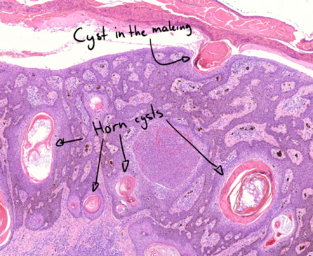43. Seborrhoeic keratosis

Staining: HE
Organ: Skin
Description:
A well-circumscribed skin lesion is visible.
The stratum corneum is thickened, meaning that there is hyperkeratosis. The cells of the stratum corneum have retained their nuclei, meaning that there is parakeratosis.

There are neutrophils in the stratum corneum. These are not related to the disease and are instead the result of the patient scratching the seborrheic keratosis, causing irritation.
The basal layer of the epidermis contains keratin cysts, called horn cysts. These are formed as the stratum corneum invaginates into the cellular layer of the epidermis, which is also visible on the slide.
There is acanthosis, which is visible as the presence of dermal cells in small nests inside the epidermis.

Diagnosis: Seborrheic keratosis
Causes:
- Unknown
- Paraneoplastic (Leser-Trelat sign)
Theory:
Sporadic seborrheic keratoses usually appear in elderly persons. If dozens of keratoses appear within a short period of time, it is a paraneoplastic syndrome called Leser-Trelat sign. This suggests an internal cancer, most commonly a GI tract carcinoma.
